
Hirschler President Courtney Paulk on one of her ultradistance open water swims. (Photos courtesy Courtney Paulk)
Hours ago, in a strait in the Baltic Sea between Germany and Denmark, Courtney Paulk was swimming to make history.
The president and longtime attorney of Richmond law firm Hirschler set out today, at 2 a.m. Central European Time, in hopes of becoming the first woman to solo swim the roughly 15-mile Fehmarn Belt strait both ways, and to beat a male swimmer’s record time – 19 hours and 13 minutes – in the process.
The feat would be but the latest in a wave of aquatic accomplishments that the 53-year-old has racked up in what’s known as ultradistance swimming: open water swims that are longer than traditional 10-kilometer (6.21-mile) marathon swims.
In 2021, Paulk was recognized as the first person in history to complete a Double Triple, or double crossings of what’s known as the Triple Crown of open swimming: the English Channel, which she swam both ways that year; the so-called “Catalina Channel” off the California coast; and a route around New York’s Manhattan Island.
Paulk completed the latter two in 2019, the year after she made more history by being named Hirschler’s first female president. She’s now been with the firm 22 years, practicing construction law.
Unfortunately, Paulk’s attempt at the Fehmarn Belt was cut short. After a couple hours in the water, her support team had to pull Paulk out due to too much marine traffic in the strait, according to a Facebook post from one of her teammates. Paulk was said to be doing well and in good spirits.
A swimmer since she was 3 years old, Paulk said it was 15 years ago when she decided to achieve the Triple Crown, committing herself to hours upon hours and miles after miles of open water swimming in typically colder temperatures, and without a wet suit, per the sport’s rules.
She said the saltwater and constant motion does a number on her physically, and the murky waters and dark nights test her psychologically, with sensory deprivation, the physical strain and lack of rest sometimes causing her to hallucinate.
The Richmond native, whose family moved to Virginia Beach while she was in high school, said she puts herself through such swims to test her limits, which she said she has reached but is always pushing further.
After finishing her first Triple Crown, becoming the 85th person in the world to do so, Paulk recalled: “I was sitting there on shore after I’d done this amazing thing, and I was trying to figure out how I could do more. I’m like, clearly I haven’t found my limit yet, so I must be doing these events to find my limit.
“When I did my two-way Catalina swim, it took me 33 hours and 13 minutes (her longest swim), and I found my limit,” she said. Paulk added that she didn’t have more to give in that swim, yet afterward caught herself wondering if her time would’ve been better if she’d eaten differently or started at a different time of day.
“I think it’s really about what you learn about yourself when your limits are tested and your character is challenged, that you’re looking for what you find out about yourself when you’re in those dark places in the middle of an open ocean trying to find your way through to get to the other side.”
Asked what she has found out about herself on her swims, Paulk replied, laughing: “That I’m pretty tough.”
“And,” she added, “that if you break things down – and this is true in work and in life – if you break the enormity of whatever task you’re going to do into the smallest possible increment, it becomes much more manageable and you can work your way through it a lot easier.”
‘I saw a walrus in the kayak’
While she’s solo on her swims, Paulk is by no means alone on the water, as a support boat crew and often a kayaker or two ride alongside her, keeping her pointed in the right direction and providing nutrition feedings every hour or half-hour, depending on the length of the swim.
On the crew every time is her husband, Matt Paulk, a Richmond General District Court judge.
Food or drinks are delivered via a line and squeeze tube that Paulk said are the only things she is allowed to touch, according to certification rules that include the no-wetsuit rule.
“You can only touch whatever the nutrition is being delivered to you,” she said. “I can’t hold onto the boat; I can’t touch the kayak. Once you’re in the water, there’s no touching of anything, except for if they throw me a bottle on a line.
“I take a combination of amylodextrin and this product called Tailwind, which is like a fancy Gatorade. I eat mashed potatoes, egg salad, apple sauce and other things that are not just liquid for (a swim) that’s more than 24 hours, because you can’t just live off liquid. Or granola bars or little pasta noodles with butter on them.”
To cope with the cold temperatures, Paulk said she trains five days a week and in cold water on weekends, sometimes traveling to chilly locales such as Ireland, where the water temps on a recent training trip were in the 50s, she said. She also has packed on pounds on purpose.
“When I started doing these swims, I gained 25 pounds, which may or may not have been necessary, but some people think that having more weight is better because it helps insulate your organs,” she said. “I have found it to be super-helpful for me to be in cold water, but I think acclimation generally is very helpful.”
To fend off any curious sea creatures, Paulk said the kayaks are sometimes equipped with electronic devices designed to keep sharks away. But she said sharks aren’t the main concern.
“Jellyfish are probably worse than anything,” she said. “In my two-way channel (swim), I got stung for four hours with these things called compass jellies. It was like soup; they were everywhere. They’re awful.”
On a recent training session at Virginia Beach, Paulk said she was bumped by what she thinks was a seal. Another time, she said, a seal bit her foot. Another time, caught on video, a seagull did the same.
More so than any creatures, Paulk said one of her biggest challenges are the hallucinations she often gets toward the tail end of longer swims. On her Catalina swim, she said she hallucinated for the last nine hours.
“I saw a walrus in the kayak. I just hallucinated all kinds of things,” she said. “It’s sensory deprivation: 21 hours in the dark on that swim. And lack of sleep. I hallucinated a walrus, and then the walrus turned into a dog. At the very end of my swim, I got onto the boat and I was still hallucinating for 24 hours.”
Enjoying the journey
After a long swim, Paulk said it takes a while to readjust, often extending the solitary experience of being out in the water.
“You’ve been by yourself for so long that you get into a flow state. I don’t think about anything. I used to sing songs to myself but I don’t do that anymore. When I get in one of these swims, everything just goes super-quiet. It takes a little while to come out of that.
“And being in saltwater, your mouth is destroyed and your stomach is kind of gross, your lips are super-swollen. And the hallucinations, they’re still there when you close your eyes,” she said. “A lot of times, I just end up sitting there wide awake for a little while, and just take in a lot of water and rehydrate. Then eventually I’ll be able to go to sleep.”
Which begs the question, again: why does Paulk put herself through it? Her answer: the journey, and the self-discovery.
“My husband says to me before every swim, ‘Enjoy the journey.’ That’s why I do it. It’s about the journey,” she said. “All of the training and getting to the start is one journey, and then doing the swim is the end of the journey.”
As for what she brings back to the office and the courtroom, Paulk said: “Just not getting rattled.”
“If I have a difficult issue come up or have a difficult judge when I’m in court, I can always say, ‘That is not as hard as swimming for 33 hours,’” Paulk said. “It gives you huge perspective, that if I’ve been able to do these hugely massive events and cross channels and ocean water of my own doing, then I can get through this meeting. It will be okay.”
This is the latest installment in our Downtime series, which focuses on business people’s pursuits outside of the office. If you, a coworker or someone you know around town has a unique way of passing time off the clock, submit suggestions to Jonathan@RichmondBizSense.com. For previous installments of Downtime, click here.

Hirschler President Courtney Paulk on one of her ultradistance open water swims. (Photos courtesy Courtney Paulk)
Hours ago, in a strait in the Baltic Sea between Germany and Denmark, Courtney Paulk was swimming to make history.
The president and longtime attorney of Richmond law firm Hirschler set out today, at 2 a.m. Central European Time, in hopes of becoming the first woman to solo swim the roughly 15-mile Fehmarn Belt strait both ways, and to beat a male swimmer’s record time – 19 hours and 13 minutes – in the process.
The feat would be but the latest in a wave of aquatic accomplishments that the 53-year-old has racked up in what’s known as ultradistance swimming: open water swims that are longer than traditional 10-kilometer (6.21-mile) marathon swims.
In 2021, Paulk was recognized as the first person in history to complete a Double Triple, or double crossings of what’s known as the Triple Crown of open swimming: the English Channel, which she swam both ways that year; the so-called “Catalina Channel” off the California coast; and a route around New York’s Manhattan Island.
Paulk completed the latter two in 2019, the year after she made more history by being named Hirschler’s first female president. She’s now been with the firm 22 years, practicing construction law.
Unfortunately, Paulk’s attempt at the Fehmarn Belt was cut short. After a couple hours in the water, her support team had to pull Paulk out due to too much marine traffic in the strait, according to a Facebook post from one of her teammates. Paulk was said to be doing well and in good spirits.
A swimmer since she was 3 years old, Paulk said it was 15 years ago when she decided to achieve the Triple Crown, committing herself to hours upon hours and miles after miles of open water swimming in typically colder temperatures, and without a wet suit, per the sport’s rules.
She said the saltwater and constant motion does a number on her physically, and the murky waters and dark nights test her psychologically, with sensory deprivation, the physical strain and lack of rest sometimes causing her to hallucinate.
The Richmond native, whose family moved to Virginia Beach while she was in high school, said she puts herself through such swims to test her limits, which she said she has reached but is always pushing further.
After finishing her first Triple Crown, becoming the 85th person in the world to do so, Paulk recalled: “I was sitting there on shore after I’d done this amazing thing, and I was trying to figure out how I could do more. I’m like, clearly I haven’t found my limit yet, so I must be doing these events to find my limit.
“When I did my two-way Catalina swim, it took me 33 hours and 13 minutes (her longest swim), and I found my limit,” she said. Paulk added that she didn’t have more to give in that swim, yet afterward caught herself wondering if her time would’ve been better if she’d eaten differently or started at a different time of day.
“I think it’s really about what you learn about yourself when your limits are tested and your character is challenged, that you’re looking for what you find out about yourself when you’re in those dark places in the middle of an open ocean trying to find your way through to get to the other side.”
Asked what she has found out about herself on her swims, Paulk replied, laughing: “That I’m pretty tough.”
“And,” she added, “that if you break things down – and this is true in work and in life – if you break the enormity of whatever task you’re going to do into the smallest possible increment, it becomes much more manageable and you can work your way through it a lot easier.”
‘I saw a walrus in the kayak’
While she’s solo on her swims, Paulk is by no means alone on the water, as a support boat crew and often a kayaker or two ride alongside her, keeping her pointed in the right direction and providing nutrition feedings every hour or half-hour, depending on the length of the swim.
On the crew every time is her husband, Matt Paulk, a Richmond General District Court judge.
Food or drinks are delivered via a line and squeeze tube that Paulk said are the only things she is allowed to touch, according to certification rules that include the no-wetsuit rule.
“You can only touch whatever the nutrition is being delivered to you,” she said. “I can’t hold onto the boat; I can’t touch the kayak. Once you’re in the water, there’s no touching of anything, except for if they throw me a bottle on a line.
“I take a combination of amylodextrin and this product called Tailwind, which is like a fancy Gatorade. I eat mashed potatoes, egg salad, apple sauce and other things that are not just liquid for (a swim) that’s more than 24 hours, because you can’t just live off liquid. Or granola bars or little pasta noodles with butter on them.”
To cope with the cold temperatures, Paulk said she trains five days a week and in cold water on weekends, sometimes traveling to chilly locales such as Ireland, where the water temps on a recent training trip were in the 50s, she said. She also has packed on pounds on purpose.
“When I started doing these swims, I gained 25 pounds, which may or may not have been necessary, but some people think that having more weight is better because it helps insulate your organs,” she said. “I have found it to be super-helpful for me to be in cold water, but I think acclimation generally is very helpful.”
To fend off any curious sea creatures, Paulk said the kayaks are sometimes equipped with electronic devices designed to keep sharks away. But she said sharks aren’t the main concern.
“Jellyfish are probably worse than anything,” she said. “In my two-way channel (swim), I got stung for four hours with these things called compass jellies. It was like soup; they were everywhere. They’re awful.”
On a recent training session at Virginia Beach, Paulk said she was bumped by what she thinks was a seal. Another time, she said, a seal bit her foot. Another time, caught on video, a seagull did the same.
More so than any creatures, Paulk said one of her biggest challenges are the hallucinations she often gets toward the tail end of longer swims. On her Catalina swim, she said she hallucinated for the last nine hours.
“I saw a walrus in the kayak. I just hallucinated all kinds of things,” she said. “It’s sensory deprivation: 21 hours in the dark on that swim. And lack of sleep. I hallucinated a walrus, and then the walrus turned into a dog. At the very end of my swim, I got onto the boat and I was still hallucinating for 24 hours.”
Enjoying the journey
After a long swim, Paulk said it takes a while to readjust, often extending the solitary experience of being out in the water.
“You’ve been by yourself for so long that you get into a flow state. I don’t think about anything. I used to sing songs to myself but I don’t do that anymore. When I get in one of these swims, everything just goes super-quiet. It takes a little while to come out of that.
“And being in saltwater, your mouth is destroyed and your stomach is kind of gross, your lips are super-swollen. And the hallucinations, they’re still there when you close your eyes,” she said. “A lot of times, I just end up sitting there wide awake for a little while, and just take in a lot of water and rehydrate. Then eventually I’ll be able to go to sleep.”
Which begs the question, again: why does Paulk put herself through it? Her answer: the journey, and the self-discovery.
“My husband says to me before every swim, ‘Enjoy the journey.’ That’s why I do it. It’s about the journey,” she said. “All of the training and getting to the start is one journey, and then doing the swim is the end of the journey.”
As for what she brings back to the office and the courtroom, Paulk said: “Just not getting rattled.”
“If I have a difficult issue come up or have a difficult judge when I’m in court, I can always say, ‘That is not as hard as swimming for 33 hours,’” Paulk said. “It gives you huge perspective, that if I’ve been able to do these hugely massive events and cross channels and ocean water of my own doing, then I can get through this meeting. It will be okay.”
This is the latest installment in our Downtime series, which focuses on business people’s pursuits outside of the office. If you, a coworker or someone you know around town has a unique way of passing time off the clock, submit suggestions to Jonathan@RichmondBizSense.com. For previous installments of Downtime, click here.


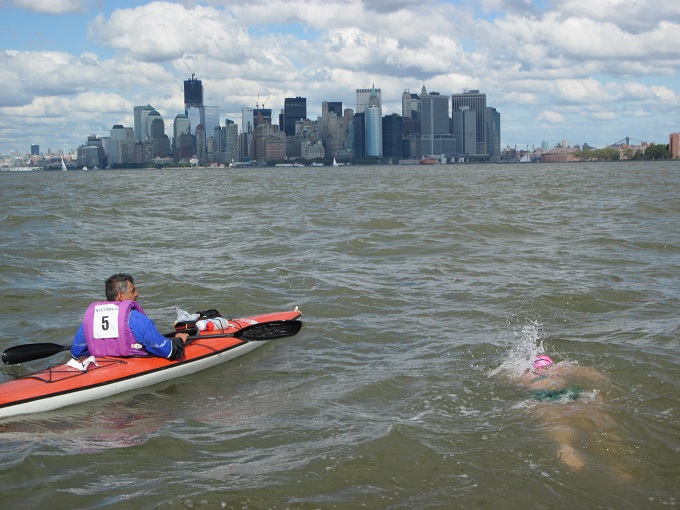
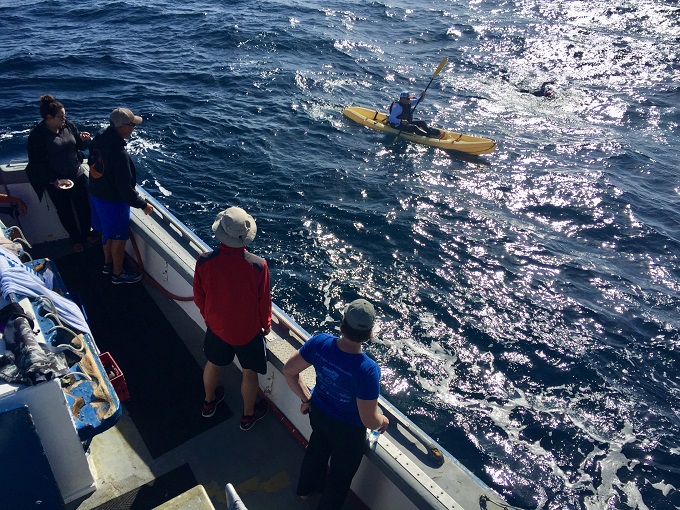
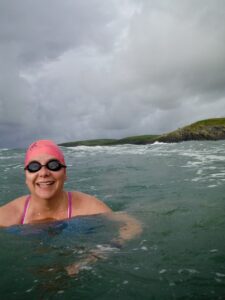
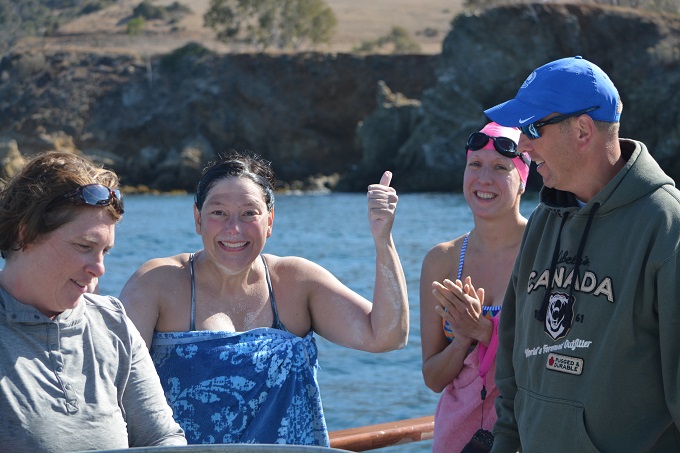
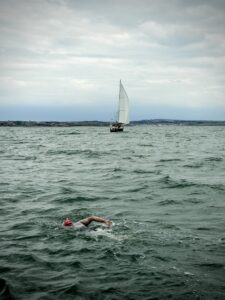


Wow. Remarkable story of endurance. Well told. Only quibble is there was not another person speaking about, including someone from org that governs this kind of swimming. But itis clear everything is well documented. Appreciate learning about her and what it takes to do what she has done. Excellent interview
Go Courtney!!
She’s the smartest and toughest construction attorney in the state of Virginia.
I read this story while sitting on my butt watching the World Cup while drinking coffee. I’m inspired to go jump in the ocean and swim! (Er, not!)
Inspiring! Thanks for sharing.
These kinds of people seem to be of a special sort mentally. I did a graduate program that contained a lot of people, both students and profs, that were into Human Performance and many were athletes with some impressive resumes. I was not one of these athletes, but while there I ran a marathon and half-marathon and several 5 and 10ks. Unfortunately, since leaving I have only run two races — Monument 10k was one of them. With that as background there was ONE person, a woman, who was one of these Ultra-Marathoners. Understand that the alleged first Marathoner died… Read more »
Go Courtney!! You are amazing! What a great story!!
Great article. Well done Courtney!